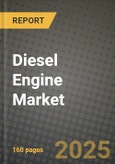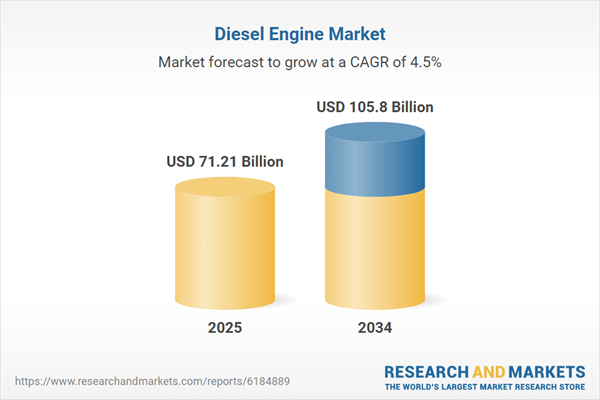Diesel Engine Market
The Diesel Engine Market is evolving from a traditional workhorse of heavy-duty mobility and power generation into a cleaner, digitally managed, and application-tailored platform. The market spans on-road commercial vehicles, off-highway equipment (construction, agriculture, mining), marine propulsion, locomotives, and stationary gensets for prime and standby power. Current trends center on higher fuel efficiency, lower emissions with advanced aftertreatment, bio/blended fuels, and digitalization through telematics, predictive maintenance, and over-the-air calibration. Growth is driven by infrastructure spending, agricultural mechanization, maritime trade, and the need for resilient backup power in data centers, hospitals, and industrial sites. Competitive dynamics feature global OEMs, regional assemblers, and a deep tier of component specialists in fuel systems, turbocharging, filtration, electronics, and exhaust aftertreatment. Manufacturers are accelerating platform modularity, common rail evolution, variable geometry boosting, and friction reduction while preparing engines for renewable diesel, biodiesel, and synthetic fuels. Parallel electrification and hybridization pressure the segment, but diesel retains an advantage in torque density, durability, and total cost of ownership in demanding duty cycles and remote operations. Emerging opportunities include micro-hybrid diesel-electric systems, genset integration with solar and battery storage, and digitized service models that lock in lifecycle value.Diesel Engine Market Key Insights
- End-use diversification sustains demand
- Emissions compliance as a design backbone
- Digital engines and predictive uptime
- Fuel flexibility and decarbonization pathways
- Hybridization where it pays
- Total cost of ownership remains king
- Turbo and injection tech race
- Aftertreatment durability in real life
- Service ecosystems and parts logistics
- Pressure from electrification and policy
Diesel Engine Market Reginal Analysis
North America
A large installed base in trucking, construction, agriculture, oil & gas, and standby power sustains demand, while emissions and noise rules drive technology refresh cycles. Fleets prize telematics, extended service intervals, and dealer support across long-haul corridors and remote worksites. Port and urban zones push cleaner calibrations, idle reduction, and hybrid auxiliaries. Data centers and healthcare maintain strong genset requirements for resilience, often integrating diesel with battery storage and controls for rapid response.Europe
Stringent air-quality and decarbonization policies accelerate engine efficiency, aftertreatment sophistication, and renewable-fuel adoption. Long-haul and vocational fleets balance TCO with low-emission zones and evolving road-charging frameworks. Off-highway segments emphasize compact packaging, noise reduction, and operator comfort. OEMs advance hybrid and fuel-agnostic strategies, while maritime and rail operators evaluate biofuels and duty-specific electrification without compromising range or tractive performance.Asia-Pacific
Infrastructure build-out, agricultural mechanization, and mining underpin robust off-highway and medium/heavy commercial demand. Diverse operating environments - from tropical humidity to high altitudes - prioritize durability and serviceability. Localized manufacturing and component ecosystems keep costs competitive, while calibration flexibility addresses varying fuel quality. Ports, coastal shipping, and regional logistics drive marine applications, and data-center expansion supports new genset installations in power-constrained grids.Middle East & Africa
Construction, mining, and oil & gas projects sustain high-load, high-temperature requirements that favor rugged engines and resilient cooling. Standby and prime power remain critical where grid reliability is variable, with operators valuing long run-time efficiency and filtration against dust and sand. Marine workboats and port equipment expand opportunities. Service partnerships, rapid parts logistics, and fuel contamination tolerance are decisive purchasing factors.South & Central America
Commodity cycles and public works programs influence off-highway equipment and trucking purchases. Operators favor platforms with proven fuel economy on challenging terrain and mixed-quality fuels. Genset demand persists for industrial continuity and remote communities, with hybrid controls smoothing load steps and conserving fuel. Distributors that offer reman, financing, and technician training gain share, as fleets standardize to reduce parts complexity and downtime.Diesel Engine Market Segmentation
By Speed
- Up to 720 rpm
- 720 to 1200 rpm
- 1200 to 1800 rpm
- Above 1800 rpm
By Power Rating
- Below 0.5 MW
- 0.5 to 1.0 MW
- 1.1 to 2.0 MW
- 2.1 to 5.0 MW
- Above 5.0 MW
By End-User
- Power generation
- Marines
- Locomotives
- Oil & Gas
- Mining
- Construction
- Others
Key Market players
Cummins, Caterpillar, John Deere, Volvo Penta, MAN Energy Solutions, MTU (Rolls-Royce Power Systems), Yanmar, Kubota, Perkins Engines, Doosan Infracore, Weichai Power, Guangxi Yuchai Machinery, Deutz AG, Mitsubishi Heavy Industries Engine & Turbocharger, Isuzu MotorsDiesel Engine Market Analytics
The report employs rigorous tools, including Porter’s Five Forces, value chain mapping, and scenario-based modelling, to assess supply-demand dynamics. Cross-sector influences from parent, derived, and substitute markets are evaluated to identify risks and opportunities. Trade and pricing analytics provide an up-to-date view of international flows, including leading exporters, importers, and regional price trends.Macroeconomic indicators, policy frameworks such as carbon pricing and energy security strategies, and evolving consumer behaviour are considered in forecasting scenarios. Recent deal flows, partnerships, and technology innovations are incorporated to assess their impact on future market performance.
Diesel Engine Market Competitive Intelligence
The competitive landscape is mapped through proprietary frameworks, profiling leading companies with details on business models, product portfolios, financial performance, and strategic initiatives. Key developments such as mergers & acquisitions, technology collaborations, investment inflows, and regional expansions are analyzed for their competitive impact. The report also identifies emerging players and innovative startups contributing to market disruption.Regional insights highlight the most promising investment destinations, regulatory landscapes, and evolving partnerships across energy and industrial corridors.
Countries Covered
- North America - Diesel Engine market data and outlook to 2034
- United States
- Canada
- Mexico
- Europe - Diesel Engine market data and outlook to 2034
- Germany
- United Kingdom
- France
- Italy
- Spain
- BeNeLux
- Russia
- Sweden
- Asia-Pacific - Diesel Engine market data and outlook to 2034
- China
- Japan
- India
- South Korea
- Australia
- Indonesia
- Malaysia
- Vietnam
- Middle East and Africa - Diesel Engine market data and outlook to 2034
- Saudi Arabia
- South Africa
- Iran
- UAE
- Egypt
- South and Central America - Diesel Engine market data and outlook to 2034
- Brazil
- Argentina
- Chile
- Peru
Research Methodology
This study combines primary inputs from industry experts across the Diesel Engine value chain with secondary data from associations, government publications, trade databases, and company disclosures. Proprietary modeling techniques, including data triangulation, statistical correlation, and scenario planning, are applied to deliver reliable market sizing and forecasting.Key Questions Addressed
- What is the current and forecast market size of the Diesel Engine industry at global, regional, and country levels?
- Which types, applications, and technologies present the highest growth potential?
- How are supply chains adapting to geopolitical and economic shocks?
- What role do policy frameworks, trade flows, and sustainability targets play in shaping demand?
- Who are the leading players, and how are their strategies evolving in the face of global uncertainty?
- Which regional “hotspots” and customer segments will outpace the market, and what go-to-market and partnership models best support entry and expansion?
- Where are the most investable opportunities - across technology roadmaps, sustainability-linked innovation, and M&A - and what is the best segment to invest over the next 3-5 years?
Your Key Takeaways from the Diesel Engine Market Report
- Global Diesel Engine market size and growth projections (CAGR), 2024-2034
- Impact of Russia-Ukraine, Israel-Palestine, and Hamas conflicts on Diesel Engine trade, costs, and supply chains
- Diesel Engine market size, share, and outlook across 5 regions and 27 countries, 2023-2034
- Diesel Engine market size, CAGR, and market share of key products, applications, and end-user verticals, 2023-2034
- Short- and long-term Diesel Engine market trends, drivers, restraints, and opportunities
- Porter’s Five Forces analysis, technological developments, and Diesel Engine supply chain analysis
- Diesel Engine trade analysis, Diesel Engine market price analysis, and Diesel Engine supply/demand dynamics
- Profiles of 5 leading companies - overview, key strategies, financials, and products
- Latest Diesel Engine market news and developments
Additional Support
With the purchase of this report, you will receive:- An updated PDF report and an MS Excel data workbook containing all market tables and figures for easy analysis.
- 7-day post-sale analyst support for clarifications and in-scope supplementary data, ensuring the deliverable aligns precisely with your requirements.
- Complimentary report update to incorporate the latest available data and the impact of recent market developments.
This product will be delivered within 1-3 business days.
Table of Contents
Companies Mentioned
- Cummins
- Caterpillar
- John Deere
- Volvo Penta
- MAN Energy Solutions
- MTU (Rolls-Royce Power Systems)
- Yanmar
- Kubota
- Perkins Engines
- Doosan Infracore
- Weichai Power
- Guangxi Yuchai Machinery
- Deutz AG
- Mitsubishi Heavy Industries Engine & Turbocharger
- Isuzu Motors
Table Information
| Report Attribute | Details |
|---|---|
| No. of Pages | 160 |
| Published | November 2025 |
| Forecast Period | 2025 - 2034 |
| Estimated Market Value ( USD | $ 71.21 Billion |
| Forecasted Market Value ( USD | $ 105.8 Billion |
| Compound Annual Growth Rate | 4.5% |
| Regions Covered | Global |
| No. of Companies Mentioned | 15 |









